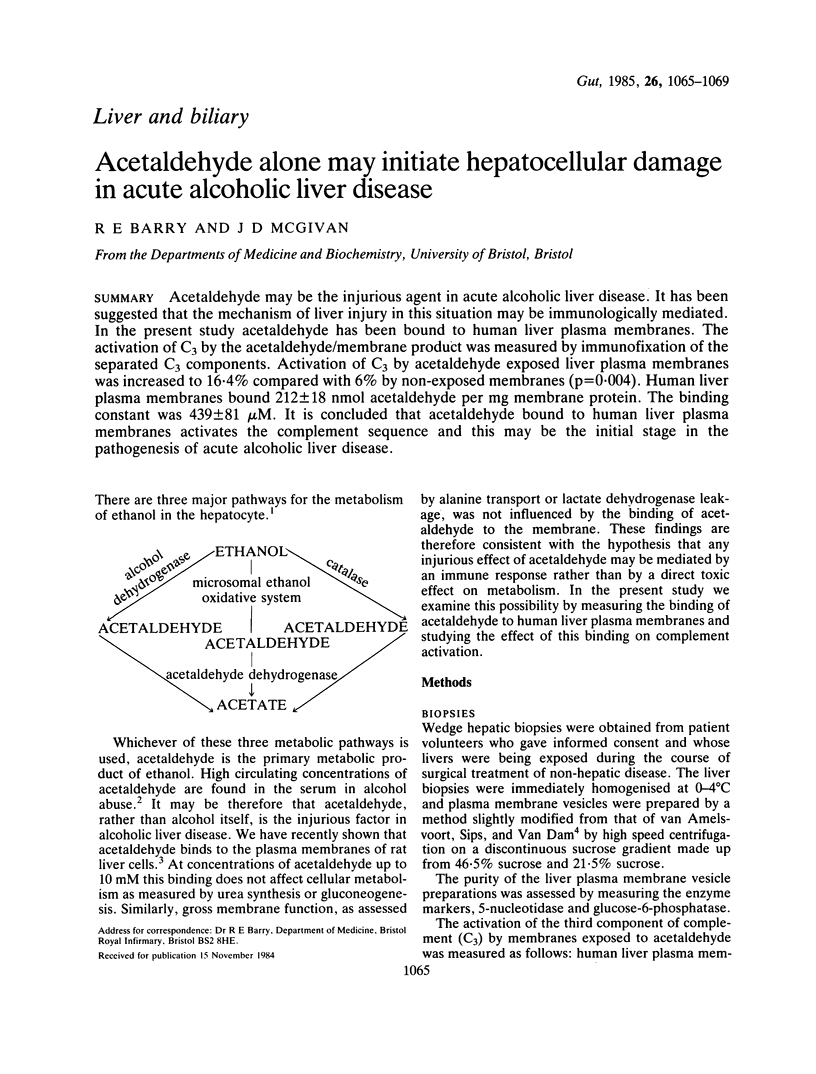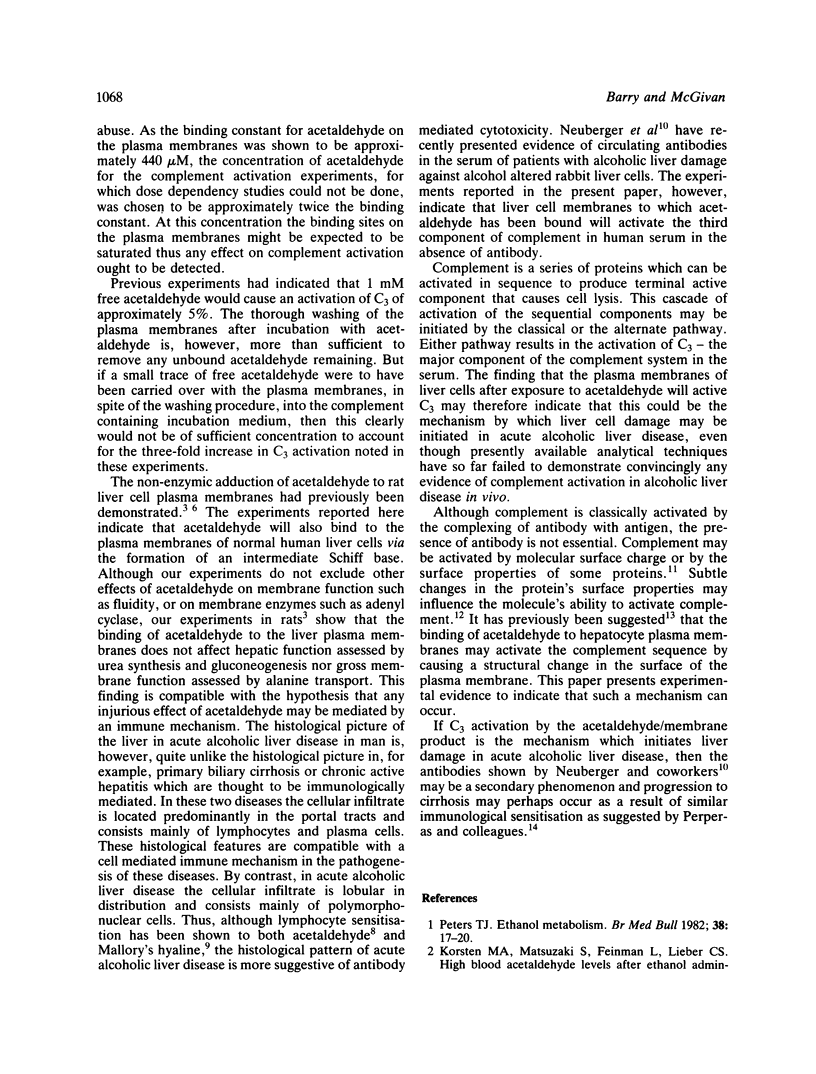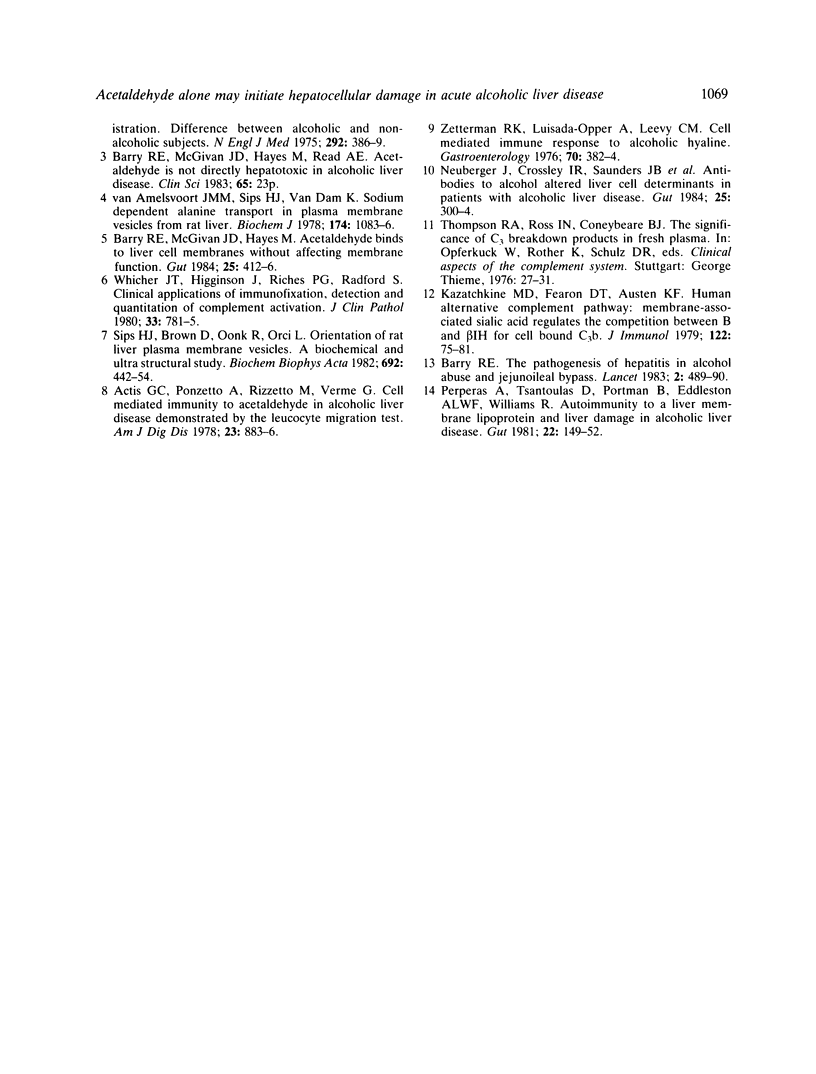Abstract
Acetaldehyde may be the injurious agent in acute alcoholic liver disease. It has been suggested that the mechanism of liver injury in this situation may be immunologically mediated. In the present study acetaldehyde has been bound to human liver plasma membranes. The activation of C3 by the acetaldehyde/membrane product was measured by immunofixation of the separated C3 components. Activation of C3 by acetaldehyde exposed liver plasma membranes was increased to 16.4% compared with 6% by non-exposed membranes (p = 0.004). Human liver plasma membranes bound 212 +/- 18 nmol acetaldehyde per mg membrane protein. The binding constant was 439 +/- 81 microM. It is concluded that acetaldehyde bound to human liver plasma membranes activates the complement sequence and this may be the initial stage in the pathogenesis of acute alcoholic liver disease.
Full text
PDF




Images in this article
Selected References
These references are in PubMed. This may not be the complete list of references from this article.
- Actis G. C., Ponzetto A., Rizzetto M., Verme G. Cell-mediated immunity to acetaldehyde in alcoholic liver disease demonstrated by leukocyte migration test. Am J Dig Dis. 1978 Oct;23(10):883–886. doi: 10.1007/BF01072460. [DOI] [PubMed] [Google Scholar]
- Barry R. E., McGivan J. D., Hayes M. Acetaldehyde binds to liver cell membranes without affecting membrane function. Gut. 1984 Apr;25(4):412–416. doi: 10.1136/gut.25.4.412. [DOI] [PMC free article] [PubMed] [Google Scholar]
- Barry R. E. The pathogenesis of hepatitis in alcohol abuse and jejunoileal bypass. Lancet. 1983 Aug 27;2(8348):489–490. doi: 10.1016/s0140-6736(83)90515-9. [DOI] [PubMed] [Google Scholar]
- Kazatchkine M. D., Fearon D. T., Austen K. F. Human alternative complement pathway: membrane-associated sialic acid regulates the competition between B and beta1 H for cell-bound C3b. J Immunol. 1979 Jan;122(1):75–81. [PubMed] [Google Scholar]
- Korsten M. A., Matsuzaki S., Feinman L., Lieber C. S. High blood acetaldehyde levels after ethanol administration. Difference between alcoholic and nonalcoholic subjects. N Engl J Med. 1975 Feb 20;292(8):386–389. doi: 10.1056/NEJM197502202920802. [DOI] [PubMed] [Google Scholar]
- Neuberger J., Crossley I. R., Saunders J. B., Davis M., Portmann B., Eddleston A. L., Williams R. Antibodies to alcohol altered liver cell determinants in patients with alcoholic liver disease. Gut. 1984 Mar;25(3):300–304. doi: 10.1136/gut.25.3.300. [DOI] [PMC free article] [PubMed] [Google Scholar]
- Perperas A., Tsantoulas D., Portmann B., Eddleston A. L., Williams R. Autoimmunity to a liver membrane lipoprotein and liver damage in alcoholic liver disease. Gut. 1981 Feb;22(2):149–152. doi: 10.1136/gut.22.2.149. [DOI] [PMC free article] [PubMed] [Google Scholar]
- Peters T. J. Ethanol metabolism. Br Med Bull. 1982 Jan;38(1):17–20. doi: 10.1093/oxfordjournals.bmb.a071726. [DOI] [PubMed] [Google Scholar]
- Whicher J. T., Higginson J., Riches P. G., Radford S. Clinical applications of immunofixation: detection and quantitation of complement activation. J Clin Pathol. 1980 Aug;33(8):781–785. doi: 10.1136/jcp.33.8.781. [DOI] [PMC free article] [PubMed] [Google Scholar]
- Zetterman R. K., Luisada-Opper A., Leevy C. M. Alcoholic hepatitis. Cell-mediated immunological response to alcoholic hyalin. Gastroenterology. 1976 Mar;70(3):382–384. [PubMed] [Google Scholar]
- van Amelsvoort J. M., Sips H. J., van Dam K. Sodium-dependent alanine transport in plasma-membrane vesicles from rat liver. Biochem J. 1978 Sep 15;174(3):1083–1086. doi: 10.1042/bj1741083. [DOI] [PMC free article] [PubMed] [Google Scholar]



